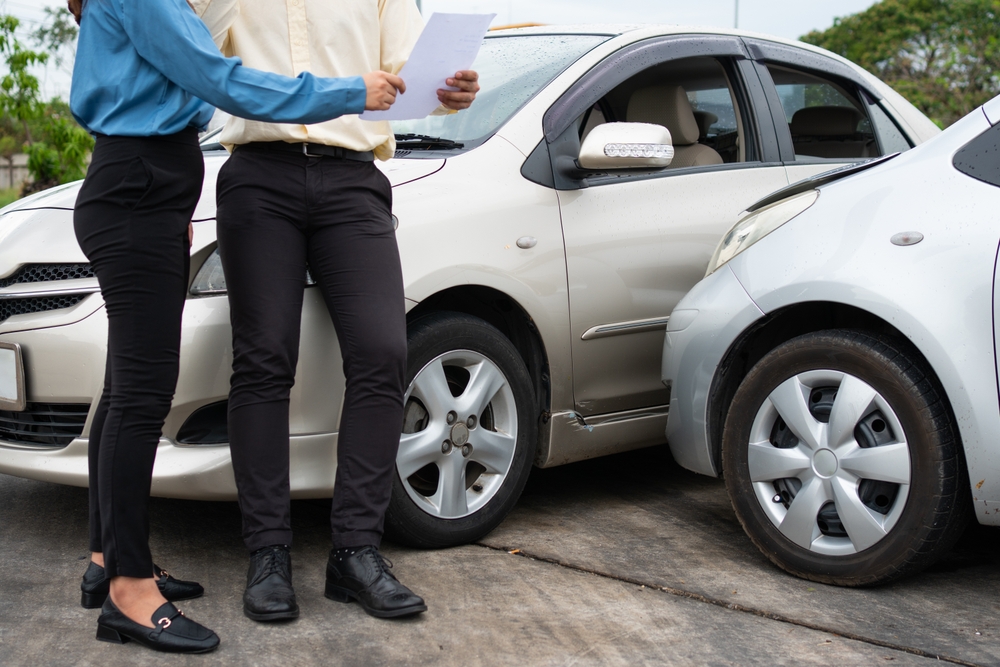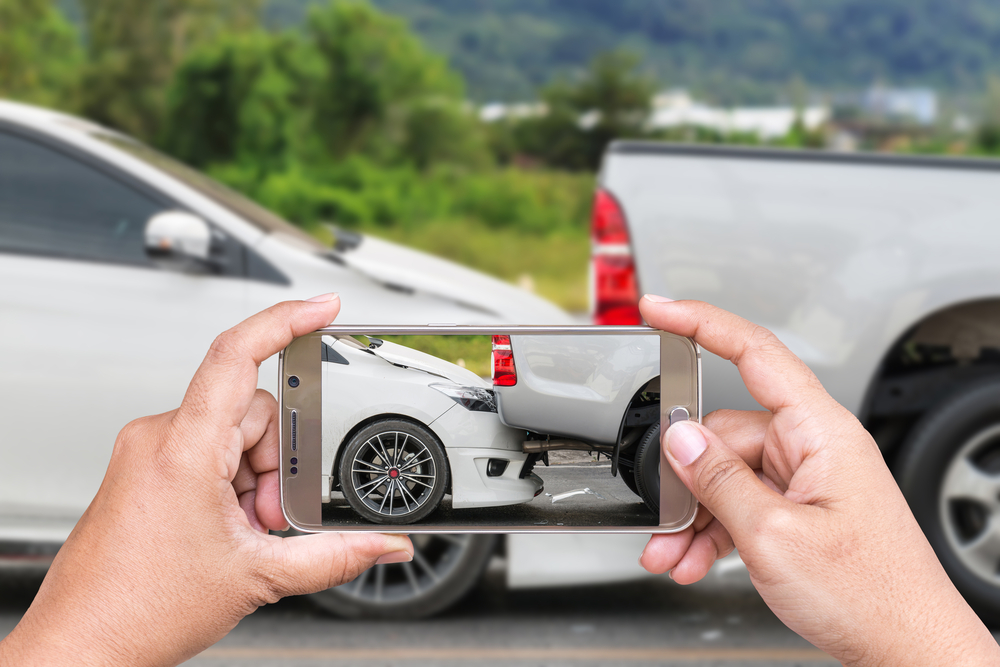
A car accident is a scary and painful experience that can leave you unsure what to do next. You may be wondering how to stay safe, protect your rights, and pursue fair compensation.
Having an experienced personal injury lawyer on your side is important, but knowing what to do after a car accident also protects your health and strengthens your insurance claim or legal case.
At Vegas Valley Injury Law, we’re here to help. This step-by-step guide outlines the steps to take at the scene and in the days that follow, helping you build a strong claim and move forward with confidence.
Immediate Safety Actions
After a crash, your top priority is making sure you and others are safe. Here are the immediate steps to take after a car accident to protect everyone at the scene:
Check for Injuries and Call Emergency Services
The first step after a crash is to call 911 so police and medical personnel can respond quickly. Check yourself, passengers, and anyone else involved for injuries, and be ready to describe them to the operator.
Emergency responders provide medical care and write an official accident report. Both are important for your safety and any claim you may file later.
Move To a Safe Location if Possible
If the vehicles are drivable and no one has major injuries, move them to the side of the road. Turning on hazard lights alerts other drivers and helps prevent a chain reaction crash. If moving isn’t possible, stay in the vehicle with your seatbelt fastened until help arrives.
Protect the Scene
Turn on your hazard lights and use cones or flares to alert oncoming traffic. Securing the area helps prevent additional accidents and protects everyone at the scene. It also reduces the chance of insurance disputes about damage that may have occurred after the initial crash. This will effectively strengthen the credibility of your claim.
Collect Critical Information
Once everyone is safe and emergency services are on their way, the next steps to take after a car accident include gathering details from the scene. Thorough documentation will protect your rights and provide evidence to prove how the accident occurred.
Exchange Contact and Insurance Details
Nevada law requires drivers to exchange information after an accident. Be sure to collect:
- Full name, phone number, and address
- Driver’s license number
- License plate number
- Insurance provider and policy number
- Vehicle make, model, and registration
Keep your interaction with other drivers brief and factual. Avoid admitting fault or apologizing, as even casual remarks can be used against you in your claim later.
Gather Witness Statements and Photos
If there are witnesses, ask for their names and contact information. A brief statement about what they saw can help with proving fault later on.
Additionally, take clear photos of:
- Damage to all vehicles
- Skid marks, debris, and road conditions
- Traffic signs, signals, or intersections
- Weather and visibility at the time of the crash
These images help preserve details that may fade from memory or change once the scene is cleared.
Document Vehicle Damage and Accident Scene
In addition to photos, take written notes about the accident. Record:
- The date, time, and exact location
- The direction each vehicle was traveling
- Road or traffic conditions (construction, heavy traffic, poor lighting)
- A simple sketch or diagram showing how the accident occurred
This documentation strengthens your credibility when explaining the accident to insurers or in court.

Reporting and Insurance Steps
Next, you must follow reporting requirements to prevent claim disputes. Here’s what to do after a car accident to properly notify your insurance company and file a report:
File a Police Report When Required
According to the Nevada Revised Statutes Chapter 484E, you must file a police report if the accident caused injury, death, or property damage over $750. Police reports create an official record, which insurance companies and courts use to verify the facts of the crash.
Even for small crashes, a police report makes your claim stronger and gives an unbiased record of what happened.
Notify Your Insurance Company Promptly
Most insurance policies require drivers to report accidents shortly after. Call your insurer as soon as possible to provide:
- Contact details for all drivers
- The police report number
- Photos of the scene and damage
- Notes you’ve taken
Keep your statements brief and factual. Avoid admitting fault or making guesses about what happened.
Keep a Detailed Record of Medical Visits and Expenses
Some injuries, like whiplash or concussions, may not appear until hours or days after a crash. Protect your health and your right to compensation by documenting every medical visit and cost.
Keep a record of:
- Emergency room or urgent care visits
- Doctor follow-ups
- Physical therapy or rehab
- Prescriptions and medical bills
Thorough records show the full impact of your injuries and make it harder for insurers to dispute your claim.
Legal Considerations After an Accident
Even after you’ve followed the steps to take after a car accident, complicated legal issues can still arise. The good news is you don’t have to handle them alone. A Nevada car accident lawyer understands state laws, protects your rights, and helps prevent unfair blame or low settlement offers.
Understanding Fault and Liability
Nevada follows a fault-based system. This means the driver responsible for causing the accident is also responsible for the damages.
However, if fault is shared, Nevada applies a modified comparative negligence rule. This means that you can recover damages as long as you are less than 50% at fault. However, your compensation will be reduced by your percentage of fault.
Dealing With Uninsured or Underinsured Drivers
If the other driver has no insurance or not enough coverage, you may still have options. You can:
- Use your own uninsured/underinsured motorist (UM/UIM) coverage
- Seek payment directly from the at-fault driver’s assets
- Work with a lawyer to explore other legal options
UM/UIM coverage isn’t required in Nevada, but it can be beneficial in these types of cases.
When to Seek Legal Advice
Not every accident requires a lawyer, but you should consider speaking with a Las Vegas car accident lawyer if:
- You or a passenger suffered serious injuries
- Fault is disputed or unclear
- The insurance company delays, denies, or undervalues your claim
- The other driver was uninsured or fled the scene
- You were involved in a multi-vehicle crash
An attorney knows what to do after a car crash and can step in to negotiate with insurers, gather evidence, and make sure you receive the maximum compensation you deserve.
Tips To Protect Your Rights and Recovery
The actions you take after a crash are key to protecting your legal rights and securing fair compensation. Knowing what to do after a car accident helps reduce stress and increases your chances of a fair settlement. Focus on these important steps:
- Keep accurate records
- Meet all deadlines
- Take care of yourself
- Seek legal guidance
Common Mistakes To Avoid After a Car Accident That Wasn’t Your Fault
Even if you’re not at fault, certain missteps can negatively impact your health and your claim. Here’s what not to do after a car crash:
Admitting Fault or Apologizing at the Scene
It’s natural to want to say “I’m sorry” after a crash, but it can be perceived as an admission of fault. Stick to the facts when talking with the other driver, witnesses, or police.
Skipping Medical Care
Many people avoid the doctor if they don’t feel seriously injured. However, delaying medical attention can worsen injuries and create doubt about whether they were caused by the accident.
Accepting a Quick Settlement From Insurance
Insurers often offer fast payouts, which lowers your settlement. Don’t settle before you know the full cost of medical care, lost wages, and other damages. Consulting an attorney can protect you from accepting less than you deserve.
Waiting Too Long To File a Claim
Nevada’s statute of limitations gives you two years after the accident occurred to file a claim. Waiting too long can weaken your case or even prevent you from seeking compensation.
Frequently Asked Questions After a Car Accident
1) Do I need to talk to the other driver’s insurance company?
No. You are not legally required to speak to the other driver’s insurer, and doing so could harm your case. Their adjuster may try to get you to say something to reduce your claim. It’s best to only communicate with your own insurance company and lawyer.
2) What information should I gather at the accident scene?
Exchange names, contact info, driver’s license numbers, vehicle registration, and insurance details. Take photos of the cars, the road, and any injuries. If there are witnesses, get their names and contact information too.
3) How soon should I see a doctor after a minor accident?
As soon as possible. Keep in mind that some injuries can take hours or days to show up. Seeing a doctor right away protects your health and establishes a record for your claim.
4) What happens if the other driver doesn’t have insurance?
You may need to use your own UM/UIM insurance coverage or consult with a lawyer to explore other options.
5) Can I still file a claim if the accident was my fault?
Yes. In Nevada, you can still recover damages if you are less than 50% at fault. Under the state’s modified comparative negligence rule, your compensation will be reduced by the percentage of fault assigned to you.
Need Help With Your Car Accident Case? Contact Vegas Valley Injury Law Today
Knowing what to do after a car accident is a strong first step, but you don’t have to go through the process alone. At Vegas Valley Injury Law, we’ve helped countless crash victims across Nevada recover the compensation they deserve.
Whether you’re dealing with an uninsured driver or fighting an insurance company that refuses to pay fairly, we’re here to stand by your side.
Our attorneys focus exclusively on injury law, combining tough advocacy with compassionate support. We offer free consultations, so there’s no risk in getting the help you need.
Your recovery starts here. Contact Vegas Valley Injury Law today and let us fight for the results you deserve.